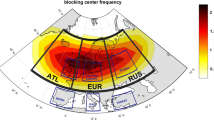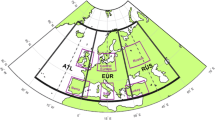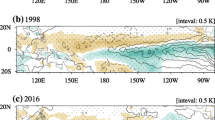Abstract
A comprehensive multivariable characterisation of the climatic impacts of winter blocking and strong zonal-flow (non-blocking) episodes over the Euro-Atlantic sector is presented here, using a 40-year (1958–97) consistent dataset from NCEP/NCAR. Anomaly fields of surface or low troposphere climate variables are then interpreted based on large-scale physical mechanisms, namely, the anomalous mean flow (characterised by the 500 hPa geopotential height and the surface wind) and the anomalous eddy activity (characterised by the surface vorticity and cyclonic activity). It is shown that the lower troposphere (850 hPa) temperature patterns are mainly controlled by the advection of heat by the anomalous mean flow. However, at the surface level, the anomaly patterns obtained for maximum and minimum temperatures present important asymmetries, associated with a different control mechanism, namely the modulation of shortwave and longwave radiation by cloud cover variations. It is shown that blocking and non-blocking episodes are typically associated with important meridional shifts in the location of maximum activity of transient eddies. The influence of persistent anomaly events in precipitable water is strongly related to the corresponding anomaly fields of lower troposphere temperature. The precipitation rate, however, appears to be essentially controlled by the surface vorticity field and preferred locations of associated cyclones.







Similar content being viewed by others
References
Anderson JL (1993) The climatology of blocking in a numerical forecast model. J Clim 6: 1041–1056
Austin JF (1980) The blocking of middle latitude westerly winds by planetary waves. Q J R Meteorol Soc 106: 327–350
Barry RG, Chorley RJ (1998) Atmosphere, weather and climate. Routledge, London, pp 409
Blender RK (1997) Identification of cyclone track regimes in the North Atlantic. Q J R Meteorol Soc 123: 727–741
Charney JG, Devore JG (1979) Multiple flow equilibria in the atmosphere and blocking. J Atmos Sci 36: 1205–1216
Christensen WC, Wiin-Nielsen A (1996) Blocking as a wave-wave interaction. Tellus 48A: 254–271
Colucci SJ, Alberta TL (1996) Planetary-scale climatrology of explosive cyclogenisis and blocking. Mon Weather Rev 124: 2509–2520
Cox AT, Cardone V, Swail VR (2000) Proc 2nd Int Conf on Reanalyse, Reading, United Kingdom. World Meteorological Organization, Geneva Switzerland. WCRP-109 (WMO/TD876), 73–76
D’Andrea F, Tibaldi S, Blackburn M, Boer G, DéquéM, Dix RM, Dugas B, Ferranti L, Iwasaki T, Kitoh A, Pope V, Randall D, Roeckner E, Strauss D, Stern W, van Den Dool H, Williamson D (1998) Northern Hemisphere atmospheric blocking as simulated by 15 atmospheric general circulation models in the period 1979–1988. Clim Dyn 14: 385–407
DaCamara CC, Kung EC, Baker WE, Lee BC, Corte-Real JAM (1991) Long-term analysis of planetary wave activities and blocking circulation in the Northern Hemisphere winter. Beitr Phys Atmos 64: 285–298
Dole RM (1986) Persistent anomalies of the extratropical Northern Hemisphere wintertime circulation: structure. Mon Weather Rev 114: 178–207
Egger J (1978) Dynamics of blocking highs. J Atmos Sci 35: 1788–1801
Elliot RD, Smith TB (1949) A study of the effect of large blocking highs on the general circulation in the northern hemisphere westerlies. J Meteorol 6: 67–85
Frederiksen JS (1982) A unified three-dimensional instability theory of the onset of blocking and cyclogenisis. J Atmos Sci 39: 969–987
Green JSA (1977) The weather during July 1976: some dynamical considerations of the drought. Weather 32: 120–126
Gulev SK, Zolina O, Grigoriev S (2001) Extratropical cyclone variability in the Northern Hemisphere winter from the NCEP/NCAR reanalysis data. Clim Dyn 17: 795–809
Hansen AR, Pandolfo JP, Sutera A (1993) Midtropospheric flow regimes and persistent wintertime anomalies of surface-layer pressure and temperature. J Clim 6: 2136–2143
Kalnay E, Kanamitsu M, Kistler R, Colins W, Deaven D, Gandin L, Iredell M, Saha S, White G, Wollen J, Zhu Y, Leetmaa A, Reynolds R, Chelliah M, Ebisuzaki W, Higgins W, Janowiak J, Mo KC, Ropelewski C, Wang J, Jenne R, Joseph D (1996) The NCEP/NCAR 40-years reanalyses project. Bull Am Meteorol Soc 77: 437–471
Kung EC, DaCamara CC, Baker WE, Susskind J, Park CK (1990) Simulations of winter blocking episodes using observed sea surface temperatures. Q J R Meteorol Soc 116: 1053–1070
Lejenäs H, Øakland H (1983) Characteristics of northern hemisphere blocking as determined from long time series of observational data. Tellus 35A: 350–362
Liu Q (1994) On the definition and persistence of blocking. Tellus 46A: 286–290
Lupo AR, Smith PJ (1994) Climatological features of blocking anticyclones in the Northern Hemisphere. Tellus 47A: 439–456
Michelangeli PA, Vautard R (1998) The dynamics of Euro-Atlantic blocking onsets. Q J R Meteorol Soc 124: 1045–1070
Mullen SL (1987) Transient eddy forcing of blocking flows. J Atmos Sci 44: 3–22
Murray RJ, Simmonds I (1991) A numerical scheme for tracking cyclones centres from digital data. Part I. Development and operation of the scheme. Aust Meteorol Mag 39: 155–166
Nakamura H, Wallace JM (1990) Observed changes in baroclinic wave activity during the life cycles of low-frequency circulation anomalies. J Atmos Sci 47: 1100–1116
Nakamura H, Nakamura M, Anderson JL (1997) The role of high- and low-frequency dynamics in blocking formation. Mon Weather Rev 125: 2074–2093
Quadrelli R, Pavan V, Molteni F (2001) Wintertime variability of Mediterranean precipitation and its links with large-scale circulation anomalies. Clim Dyn 17: 457–466
Quiroz RS (1984) The climate of 1983–84 winter. A season of strong blocking and severe cold in North America. Mon Weather Rev 112: 1894–1912
Reid PA, Jones PD, Brown O, Goodess CM, Davies TD (2001) Assessments of the reliability of NCEP circulation data and relationships with surface climate by direct comparisons with station based data. Clim Res 17: 247–261
Reinhold BB, Pierrehumbert RT (1982) Dynamics of weather regimes: quasi-stationary waves and blocking. Mon Weather Rev 110:1105–1145
Rex DF (1950a) Blocking action in the middle troposphere and its effect upon regional climate. Part I. An aerological study of blocking action. Tellus 2: 196–211
Rex DF (1950b) Blocking action in the middle troposphere and its effect upon regional climate. Part II. The climatology of blocking action. Tellus 2: 275–301
Rex DF (1951) The effect of Atlantic blocking action upon European climate. Tellus 3: 1–16
Sausen R, König W, Sielmann F (1995) Analysis of blocking events observation and ECHAM model simulations. Tellus 47A: 421–438
Serreze MC, Carse F, Barry RG, Rogers JC (1997) Icelandic Low cyclone activity: climatological features, linkages with the NAO, and relationships with recent changes in the Northern Hemisphere circulation. J Clim 10: 453–464
Shutts GJ (1983) The propagation of eddies in diffluent jet streams: eddy forcing of “blocking” flow fields. Q J R Meteorol Soc 109: 737–762
Shutts GJ (1986) A case study of eddy forcing during an Atlantic blocking episode. In: Benzi R, Saltzman B, Wiin-Nielsen AC (eds) Anomalous atmospheric flows and blocking. Advances in Geophysics, vol 29, Academic Press, New-York, pp 135–162
Sinclair MR (1994) An objective cyclone climatology for Southern Hemisphere. Mon Weather Rev 122: 1156–1167
Simmons AJ, Wallace JM, Branstator GW (1983) Barotropic wave propagation and instability, and atmospheric telleconnection patterns. J Atmos Sci 40: 1363–91
Stein O (2000) The variability of Atlantic-European blocking as derived from long SLP time series. Tellus 52A: 225–236
Tibaldi S, Molteni F (1990) On the operational predictability of blocking. Tellus 42A: 343–365
Tibaldi S, Tosi E, Navarra A, Pedulli L (1994) Northern and Southern Hemisphere seasonal variability of blocking frequency and predictability. Mon Weather Rev 122: 1971–2003
Tibaldi S, D’Andrea F, Tosi E, Roeckner E (1997) Climatology of Northern Hemisphere blocking in the ECHAM model. Clim Dyn 13: 649–666
Treidl RA, Birch EC, Sajecki P (1981) Blocking action in the Northern Hemisphere: a climatological study. Atmosphere-Ocean 19: 1–23
Trigo IF, Davies TD, Bigg GR (1999) Objective climatology of cyclones in the Mediterranean region. J Clim 12: 1685–1696
Trigo IF, Bigg GR, Davies TD (2002) Climatology of cyclogenesis mechanisms in the Mediterranean. Mon Weather Rev 130: 549–569
Trigo RM, DaCamara CC (2000) Circulation weather types and their impact on the precipitation regime in Portugal. Int J Climatol 20: 1559–1581
Trigo RM, Osborn TJ, Corte-Real JM (2002) The North Atlantic Oscillation influence on Europe: climate impacts and associated physical mechanisms. Clim Res 20: 9–17
Tsou CH, Smith PJ (1990) The role of synoptic/planetary-scale interactions during the development of a blocking anticyclone. Tellus 42A: 174–193
Tung KK, Lindzen RS (1979) A theory of stationary long waves. 1 A simple theory of blocking. 2. Resonant Rossby waves in the presence of realistic vertical shears. Mon Weather Rev 107: 735–750
Verdecchia M, Visconti G, D’Andrea F, Tibaldi S (1996) A neural network approach for blocking recognition. Geophys Res Lett 23: 2081–2084
Widmann M, Bretherton CS (2000) Validation of mesoscale precipitation in the NCEP reanalysis using a new gridcell dataset for the northwestern United States. J Clim 13: 1936–1950
Wilby RL, O’Hare G, Barnsley N (1997) The North Atlantic Oscillation and the British Isles climate variability 1865–1995. Weather 52: 266–276
White G (2000) Long-term trends in NCEP/NCAR Reanalysis. Proc 2nd Int Conf on Reanalyse, Reading, United Kingdom. World Meteorological Organization, Geneva Switzerland. WCRP-109 (WMO/TD985), 54–57
**e P, Arkin PA (1997) Global precipitation: a 17-year monthly analysis based on gauge observations, satellite estimates and numerical model outputs. Bull Am Meteorol Soc 78: 2539–2558
Zolina O, Gulev SK (2002) Improving accuracy of map** cyclone numbers and frequencies. Mon Weather Rev 129: 748–759
Acknowledgements
The Reanalyses data have been produced by the NCEP and NCAR DSS. The window (30°N–80°N, 60°E–70°W) has been extracted and kindly provided by Ian Harris and David Viner (CRU). The authors would like to acknowledge Dr. Jean Palutikof and Ms. Célia Gouveia for their helpful suggestions.
Author information
Authors and Affiliations
Corresponding author
Appendix
Appendix
1.1 Cyclone tracking algorithm
The detection and tracking of North Atlantic cyclones is based on an algorithm previously developed for the Mediterranean region by Trigo IF et al. (1999). Both the detection and tracking schemes are performed using 6-hourly sea level pressure (SLP), available from NCEP/NCAR reanalyses on a 2.5° × 2.5° grid. The data cover the area from 30°N to 80°N and 60°W to 70°E, and the period 1958–97.
A candidate cyclone is identified as a local SLP minimum, over a 3 × 3 grid point area. To be considered a cyclone, this minimum must fulfil two thresholds found empirically:
-
1.
A maximum value of 1020 hPa is required for the central sea level pressure
-
2.
The mean pressure gradient, estimated for an area of 12.5° long. × 10° lat. around the minimum pressure, must be at least 0.55 hPa/100 km
The cyclone tracking algorithm is based on a nearest-neighbour search procedure (as in Blender et al. 1997; Serreze et al. 1997): a cyclone’s trajectory is determined by computing the distance to cyclones detected in the previous chart and assuming the cyclone has taken the path of minimum distance; if the nearest neighbor in the previous chart is not within an area determined by imposing a maximum cyclone velocity of 50 km/h in the westward direction and of 110 km/h in any other, then cyclogenesis is assumed to have occurred. Again, these thresholds were determined empirically by observing cyclone behaviour in SLP charts.
Rights and permissions
About this article
Cite this article
Trigo, R.M., Trigo, I.F., DaCamara, C.C. et al. Climate impact of the European winter blocking episodes from the NCEP/NCAR Reanalyses. Climate Dynamics 23, 17–28 (2004). https://doi.org/10.1007/s00382-004-0410-4
Received:
Accepted:
Published:
Issue Date:
DOI: https://doi.org/10.1007/s00382-004-0410-4




